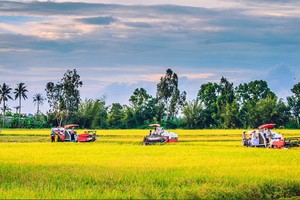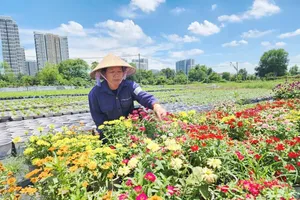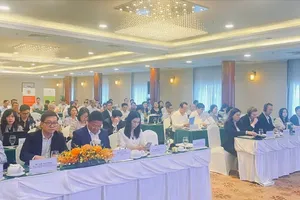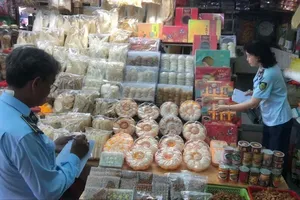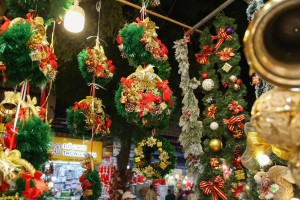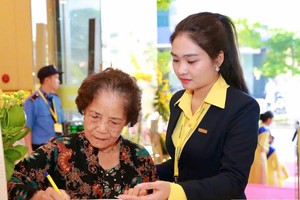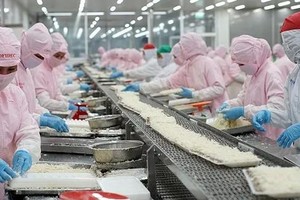
Lately, in mid-October this year, Chile announced that it accepts the import of fresh pomelos (citrus maxima) from Vietnam. Earlier, at the end of June, for the first time, Hai Duong and Bac Giang provinces exported nearly 5 tons of lychee to Japan by air, marking an open opportunity for lychees to access major and fastidious markets, as well as meet the expectations of farmers in the well-known lychee-growing areas of Thanh Ha and Luc Ngan districts.
Not only waiting for partners to come and learn, but many provinces have also planned quite methodical fruit offers. Recently, Cao Phong orange - the main agricultural product brand of Hoa Binh Province, with four main varieties of orange, including Citrus sinensis, Citrus myrtifolia, and Valencia orange, was evaluated and ranked as 3-star OCOP products. The province has determined to upgrade Cao Phong orange to 4-star and 5-star OCOP products to create favorable conditions to advertise for export. At the end of last November, Bac Giang Province held a trade fair on oranges, pomelos, and typical products of the Luc Ngan District. The focus of the fair is the association with Stars Logistics Joint Stock Company to open an electronic trading floor to bring oranges, pomelos, and typical products of Luc Ngan District to the electronic trading floor to invite domestic and foreign partners.
According to the Department of Crop Production under the MARD, the Mekong Delta provinces currently have more than 362,000 hectares of fruit trees, accounting for more than 34 percent of the total area of fruit trees in the country. Tien Giang Province has the largest area of fruit trees with more than 78,000 hectares, followed by Vinh Long with over 47,000 hectares, Hau Giang with more than 36,000 hectares, and Dong Thap with 31,000 hectares. The remaining provinces have an area of from 6,000 to 28,000 hectares of fruit trees.
Types of fruit trees in the Mekong Delta provinces include mango, banana, dragon fruit, orange, tangerine, pomelo, longan, durian, jackfruit, rambutan, custard apple, mangosteen, guava, plum, Manilkara zapota, soursop, and pineapple. Many types of fruit trees with an area of over 10,000 hectares, such as citrus, mango, longan, durian, banana, dragon fruit, pineapple, jackfruit, and rambutan. Every year, provinces in the Mekong Delta alone provide the market with over 4 million tons of fruit for export and domestic consumption.
However, whether in the form of inviting foreign partners or being accepted by official agencies for import, Vietnamese fruits still must pass technical barriers if we want to export sustainably.
As for lychee products, in 2014, the Department of Plant Protection under the MARD started negotiations with the Ministry of Agriculture, Forestry, and Fisheries of Japan to promote and open the market for Vietnamese lychees to enter the Japanese market. Several strict experiments were then carried out to ensure the thorough removal and destruction of microorganisms that can exist on the litchi fruits.
The Vietnam Trade Office in Japan also arranged to bring partners from Japan to Bac Giang Province to learn about Luc Ngan lychee fruit and fresh litchi preservation technology three times in 2018 and 2019. And on December 15 last year, after more than five years of negotiation between the two sides, the Ministry of Agriculture, Forestry, and Fisheries of Japan officially announced the door opening for Vietnamese lychee fruit to be exported directly to Japan under three conditions, including being grown in orchards directly inspected, supervised, and granted growing-area codes by the Department of Plant Protection, meeting Japanese regulations on phytosanitary and food safety. Batches of exported lychees must be packed and fumigated with methyl bromide at facilities recognized by the Department of Plant Protection and the Ministry of Agriculture, Forestry, and Fisheries of Japan, with a minimum dose of 32 grams per cubic meters for two hours under the supervision of Vietnamese and Japanese plant quarantine officers. The batches of lychees must be attached with a phytosanitary certificate issued by the Department of Plant Protection.
Recognizing the importance of technical barriers to each country, Vietnamese enterprises and farmers have started to join and participate in more and more methodical export. For instance, although Cao Phong orange obtained geographical indication since 2017, Cao Phong Orange 3T Farm Cooperative continues to standardize the production and care process following the GlobalGAP. Nearly 30 hectares of orange trees are carrying out well the use of organic agricultural materials for fertilization. When harvested, oranges are carefully selected, only about 8-10 percent of total fruit yield meets the standards of color, size, and quality. After sorting, oranges are sent to the washing division, disinfected by ultraviolet radiation, and stamped traceability on each orange before packing into beautifully-designed gift boxes.
These efforts aim to reach the lowest level of technical barriers so that when being accepted by a certain market, Cao Phong orange will easily fulfill the specific requirements of that market.
Similarly, for the export of pomelos to Chile, bananas to Japan, or dragon fruit, passion fruit to the EU market, the lowest standards are being granted the codes of growing areas under the GlobalGAP standards; each batch of fruits must be treated with irradiation and issued an export certificate. Next is to meet the standards on phytosanitary and animal quarantine, depending on the requirements of each specific market. With the above necessary and sufficient conditions, Vietnamese fruits will confidently export to foreign countries.
Not only waiting for partners to come and learn, but many provinces have also planned quite methodical fruit offers. Recently, Cao Phong orange - the main agricultural product brand of Hoa Binh Province, with four main varieties of orange, including Citrus sinensis, Citrus myrtifolia, and Valencia orange, was evaluated and ranked as 3-star OCOP products. The province has determined to upgrade Cao Phong orange to 4-star and 5-star OCOP products to create favorable conditions to advertise for export. At the end of last November, Bac Giang Province held a trade fair on oranges, pomelos, and typical products of the Luc Ngan District. The focus of the fair is the association with Stars Logistics Joint Stock Company to open an electronic trading floor to bring oranges, pomelos, and typical products of Luc Ngan District to the electronic trading floor to invite domestic and foreign partners.
According to the Department of Crop Production under the MARD, the Mekong Delta provinces currently have more than 362,000 hectares of fruit trees, accounting for more than 34 percent of the total area of fruit trees in the country. Tien Giang Province has the largest area of fruit trees with more than 78,000 hectares, followed by Vinh Long with over 47,000 hectares, Hau Giang with more than 36,000 hectares, and Dong Thap with 31,000 hectares. The remaining provinces have an area of from 6,000 to 28,000 hectares of fruit trees.
Types of fruit trees in the Mekong Delta provinces include mango, banana, dragon fruit, orange, tangerine, pomelo, longan, durian, jackfruit, rambutan, custard apple, mangosteen, guava, plum, Manilkara zapota, soursop, and pineapple. Many types of fruit trees with an area of over 10,000 hectares, such as citrus, mango, longan, durian, banana, dragon fruit, pineapple, jackfruit, and rambutan. Every year, provinces in the Mekong Delta alone provide the market with over 4 million tons of fruit for export and domestic consumption.
However, whether in the form of inviting foreign partners or being accepted by official agencies for import, Vietnamese fruits still must pass technical barriers if we want to export sustainably.
As for lychee products, in 2014, the Department of Plant Protection under the MARD started negotiations with the Ministry of Agriculture, Forestry, and Fisheries of Japan to promote and open the market for Vietnamese lychees to enter the Japanese market. Several strict experiments were then carried out to ensure the thorough removal and destruction of microorganisms that can exist on the litchi fruits.
The Vietnam Trade Office in Japan also arranged to bring partners from Japan to Bac Giang Province to learn about Luc Ngan lychee fruit and fresh litchi preservation technology three times in 2018 and 2019. And on December 15 last year, after more than five years of negotiation between the two sides, the Ministry of Agriculture, Forestry, and Fisheries of Japan officially announced the door opening for Vietnamese lychee fruit to be exported directly to Japan under three conditions, including being grown in orchards directly inspected, supervised, and granted growing-area codes by the Department of Plant Protection, meeting Japanese regulations on phytosanitary and food safety. Batches of exported lychees must be packed and fumigated with methyl bromide at facilities recognized by the Department of Plant Protection and the Ministry of Agriculture, Forestry, and Fisheries of Japan, with a minimum dose of 32 grams per cubic meters for two hours under the supervision of Vietnamese and Japanese plant quarantine officers. The batches of lychees must be attached with a phytosanitary certificate issued by the Department of Plant Protection.
Recognizing the importance of technical barriers to each country, Vietnamese enterprises and farmers have started to join and participate in more and more methodical export. For instance, although Cao Phong orange obtained geographical indication since 2017, Cao Phong Orange 3T Farm Cooperative continues to standardize the production and care process following the GlobalGAP. Nearly 30 hectares of orange trees are carrying out well the use of organic agricultural materials for fertilization. When harvested, oranges are carefully selected, only about 8-10 percent of total fruit yield meets the standards of color, size, and quality. After sorting, oranges are sent to the washing division, disinfected by ultraviolet radiation, and stamped traceability on each orange before packing into beautifully-designed gift boxes.
These efforts aim to reach the lowest level of technical barriers so that when being accepted by a certain market, Cao Phong orange will easily fulfill the specific requirements of that market.
Similarly, for the export of pomelos to Chile, bananas to Japan, or dragon fruit, passion fruit to the EU market, the lowest standards are being granted the codes of growing areas under the GlobalGAP standards; each batch of fruits must be treated with irradiation and issued an export certificate. Next is to meet the standards on phytosanitary and animal quarantine, depending on the requirements of each specific market. With the above necessary and sufficient conditions, Vietnamese fruits will confidently export to foreign countries.





